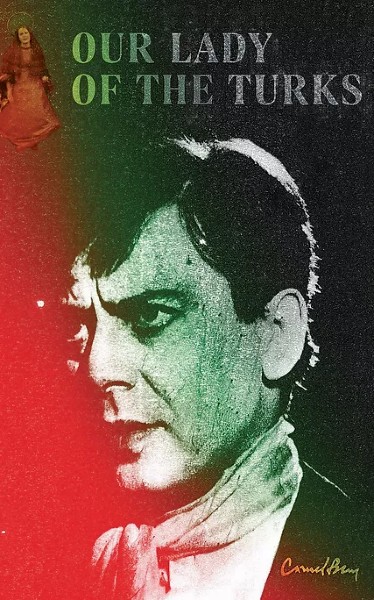 By CARMELO BENE (Contra Mundum; 2021)
By CARMELO BENE (Contra Mundum; 2021)
This is a big deal: the premiere English translation of the only novel by Italy’s late Carmelo Bene. OUR LADY OF THE TURKS is the latest dispatch from the Bene-ssance that commenced in 2020, with the long-in-coming publications of Bene’s I APPEARED TO THE MADONNA and Mario Massini’s MY FILMS WITH CARMELO BENE.
This novel, which was adapted for an “anti-1968 film” by Bene himself, is a phantasmagoric swirl of discordant language that can be read, variously, as surrealist literature in the mold of authors like Giorgio de Chirico and Robert Desnos, an eccentric autobiography or an especially trenchant satire. In fact it’s all those things, with, in the words of translator Carole Viers-Andronico, “no explanations given, nor any elucidation provided. There are only black holes.”
…a phantasmagoric swirl of discordant language that can be read, variously, as surrealist literature…
The ostensible subject is the 1480 invasion of Otranto by the Ottomans. That’s evident in the constant claims of a “Turkish invasion” by the protagonist, an Otranto resident whose age is indeterminate (at one point he ponders his actions of “five centuries ago”), and who frequently changes his appearance and personality (with guises that include a monk, a friar and a knight). Some knowledge about Bene’s background is required for a partial understanding of this novel (a full understanding is probably impossible), as is an awareness of the events of 1480 (a viewing of the OUR LADY OF THE TURKS film wouldn’t hurt, either). A brief history lesson is thankfully provided in a preface by Viers-Andronico, who relates the particulars of the Otranto invasion, while Bene’s life story is outlined in the aforementioned books.
The “invasion” here is metaphoric, consisting of Turkish sightseers who amid a succession of parades and fireworks displays annoy the protagonist no end. Further irritation is provided by the title character, a spectral woman known as Saint Margherita who serves as both a domestic companion and an object of unattainable fantasy, and also two mysterious children that (like the unidentified young boy who flits in and out of the OUR LADY OF THE TURKS film) can be viewed as personifications of Bene’s son, who died at age five.
The “invasion” here is metaphoric, consisting of Turkish sightseers who amid a succession of parades and fireworks displays annoy the protagonist no end.
The protagonist, an unflagging narcissist (the book opens with him gazing into a mirror and proclaiming “Love me!”), is given to lengthy ruminations that yield passages of freeform poetic beauty (as when he finds himself playing a four person chess game with Margherita, the “memory of her” and the “memory of him”) and a number of eccentric insights about art, the theater and divinity that, in their artful dissonance, are unique to Carmelo Bene. Yet a healthy sense of the ridiculous is ever-present, with the protagonist desiring above all else to become an “idiot,” and frustrated that everyone around him seems determined to make him a saint; as he likes to claim, “There are idiots who have seen the Madonna, and there are idiots who have not seen the Madonna,” with himself, he asserts, landing squarely in the latter category.
Translating this crazed masterwork was, as Viers-Andronico admits, no easy task. It is, she claims, “not a repeat performance; it is an “other” performance” that “endeavors to stare into an empty mirror identical to the one Bene embodied.” Utilized is unconventional and often jarring syntax, with frequent use made of the “&” symbol. Precisely how close it is to the Italian language original I have no idea, but Bene’s peculiar genius does appear to shine through.
